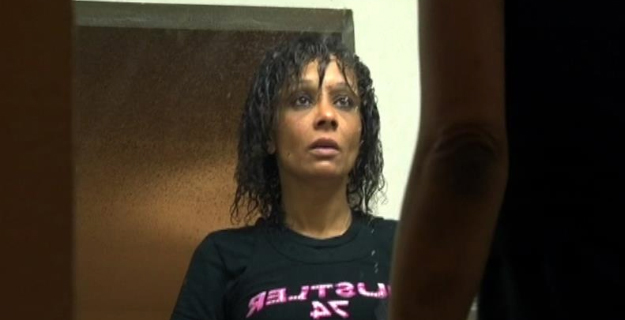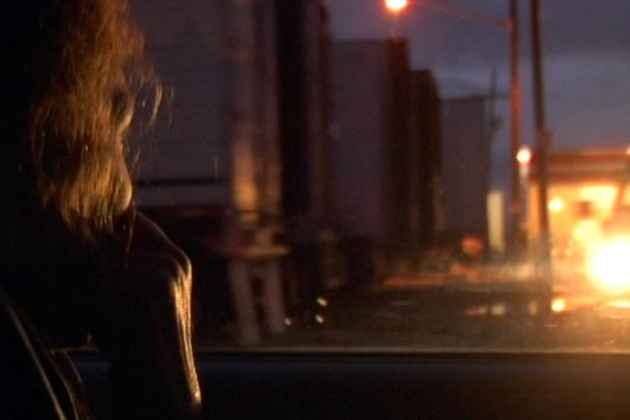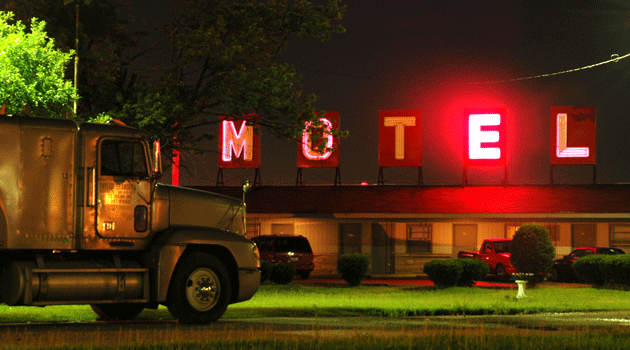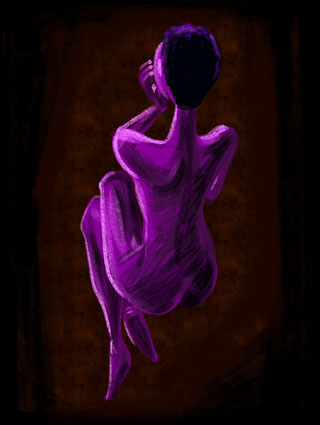
Monica prepares to work the lot.Photo courtesy Alexander Perlman.
“The truth is, making the movie was a really traumatic experience. I suspect I may have developed some mild PTSD.” This is how filmmaker Alexander Perlman describes shooting Lot Lizard, his hypnotic new documentary about truck stop prostitution. While his claim might sound hyperbolic—or like a canny bit of marketing—it rings true: He logged thousands of miles and hundreds of hours to make the film, braving roach motels, crack highs, and homicidal pimps. Indeed, what Perlman captures in Lot Lizard is visceral and harrowing.
The film’s three protagonists—Betty, Monica, and Jennifer—work on the fringes of the trucking industry. America’s Independent Truckers’ Association estimates there are nearly 5,000 truck stops across the country, and although many offer nondescript places to sleep, eat, or shower, many others host a bustling shadow economy of sex and drugs. Lurk on truckers’ online message boards long enough and you’ll likely come across what amounts to a guide to interstate sex, replete with lurid tall tales (see here, here, and here).
Life on the road, they say, is lonely. To quote one trucker in Lot Lizard: “These walls close in on you. Being in this truck can actually make you crazy.” As Perlman discovered, however, the women—and, occasionally, men—who cater to this loneliness don’t fare much better. Betty and Monica are addicted to crack, Monica is homeless when she’s not crashing with friends or sympathetic drivers, and both are entangled in dysfunctional relationships. “I can feel money,” Betty says, a kind of human divining rod, and yet she spends most of the film desperately searching for just that.
Jennifer, an ex-addict and single mother who recently quit prostitution, struggles to maintain her sobriety. She buys a house but can’t find a job. With time and money running out, she weighs the economics of earning minimum wage at a McJob versus hustling on the lot again. (Guess which pays more?) It’s a particularly wrenching moment in a film loaded with them.
I recently spoke with Alexander Perlman about life on the lots, dodging the police, and what he left on the cutting room floor.
Mother Jones: So this film was inspired by a truck stop prostitute you met while hitchhiking from New York to San Francisco?
Alexander Perlman: Yes. It was midday at a truck stop in Ohio, and I was sitting on a bench outside the travel center. My camping bag lay on the table next to me and a cardboard sign with the word “WEST” scrawled on it. A woman sat down and struck up a conversation. I assumed she was a truck driver. We were in the middle of talking about her grandchildren when a truck driver who looked like Santa Claus walked by. She offered to show him her breasts for $10, he took her up on it, and they walked off into the sunset.
MJ: What was it about the encounter that intrigued you?
AP: There was something about the set of her jaw—she had the strength of someone who had come to grips with a hard life. Also, it was clear that she was living outside the bounds of traditional society. On a much smaller scale I knew what that was like—I hit a rough patch in my teens and almost dropped out of high school. I identified with her, as I identify with anyone who doesn’t really fit the mold.
MJ: How did you choose specific truck stops?
AP: The majority of filming was done over eight weeks. Dan Livingston, the field producer, looked for ride shares on Craigslist and eventually found one with Juliana Star Asis, his friend who was headed to Tucson, Arizona. We set out from New York, drove south on I-95, then west on I-10 until we hit L.A. We did a lot of research online and spoke with truck drivers to find out where the sex workers were most prevalent. We put together a map indicating hotspots around the country. In the end, it came down to luck. A lot of the truck stops were clean as a whistle. When that happened, we hit the road.
MJ: You focus on three women—Betty, Monica, and Jennifer. How did you describe the project to them?
AP: We pitched the film as a feature documentary about truck stop sex workers. We resolved ahead of time that we wouldn’t pay them because we thought that would make the film disingenuous. Unsurprisingly, most of them turned us down. We had to go through a large volume of sex workers to find our cast.
They weren’t writers, filmmakers, musicians, or painters. They had no outlets, but like everyone else had a need to express themselves and sort out their personal histories. Eventually we became their therapists—listening patiently, empathizing, asking questions, and being there for them to the best of our abilities. By the end it was challenging to document rather than participate. My experience on the project helped me recognize that I would rather be a participant. I’m applying to MSW programs in February.
MJ: Describe the different codes or shorthand that prostitutes use when advertising themselves on CB radios.
AP: Where do I begin? Most truck drivers refer to the sex workers as “lot lizards.” The girls prefer the term “working girls.” They call the act itself “turning a trick” or “dating.” I find the euphemisms indicative.
“Commercial Company” refers to sex workers, as in, “any commercial out there tonight?” Or, “anybody looking for some company?” The sex workers play an elaborate game of tag with the security guards and police officers. The sex workers hide in a “safe truck” when the heat turns up. It’s kind of like base. In the truck, they use the CB to advertise their services and arrange to meet with other truckers on the lot. There can be several safe trucks on a large lot.
“40-60-80” is shorthand for a fairly standard rate: $40 for oral sex, $60 for sex, and $80 for both. When arranging deals over the CB radio, the sex workers would ask the truck drivers, “what color is your house?” Which means, “what does your truck look like?”
MJ: The film briefly introduces a gay male prostitute offering “massages.” How common are male sex workers on the lot?
AP: We heard a lot of stories, but the only one we met was Jesse. I think there’s less demand for male sex workers. There’s the risk of violence motivated by homophobia.
MJ: None of the women you profiled had pimps. Did you meet any who did?
AP: We met some pimps. One of them had a grill, a giant, gem-encrusted belt buckle in the shape of a “G,” and a bottle of scotch in his breast pocket. This begs the question: Why did none of them feature prominently in the film? Unfortunately, the pimps prohibited it.
One of the concerns we had with our lead characters is that selecting them downplays the prevalence of pimps and trafficking in the industry. There’s an amazing organization called Truckers Against Trafficking that addresses the issue. We had to bite the bullet on that because we just didn’t have the footage to deal with the issue of trafficking in a meaningful way that was consistent with the rest of the film.
MJ: Describe the police or security presence on the lot.
AP: It varied. Like I said, some truck stops were clean as a whistle. Others were out of control. When police rolled through, truckers would announce their arrival and precise location. If you closed your eyes and listened you could see the police cars driving around the lot. The sex workers hid out in safe trucks until the lot cleared.
In many truck stops, security was comically ineffective. Some of them enjoyed ogling the sex workers as much as the truck drivers did. We heard stories about security guards and police officers receiving “favors” in exchange for freedom, but can’t verify these. It seemed there was a bias towards targeting the sex workers as opposed to Johns. It makes sense from the truck stop’s perspective—they don’t want to alienate paying customers.
MJ: The film depicts both prostitutes and truckers as victims in this larger drama of human appetites and loneliness. Do you see both parties as victims? How would you describe the power dynamic?
AP: As one sex worker put it: “We sell our bodies, they sell their time—how different are those really?” Both truck drivers and sex workers were doing a job that wore them down emotionally, but the money was good enough to keep them working.
Power dynamics varied from one person to the next. In some cases, it seemed like truck drivers were taking advantage of sex workers, in others like sex workers were taking advantage of truck drivers, and, in a rare few, it seemed there was mutual respect.
MJ: One of the film’s most powerful moments is Jennifer’s reunion with the trucker who introduced her to prostitution. How did that come about?
AP: Oddly enough it was Jennifer’s suggestion. It seemed like she needed a sense of closure and empowerment. Ultimately, I think she bit off more than she could chew. It’s hard to confront your past when you’re struggling to redefine yourself.
I think he [the trucker] was in love with Jennifer and that he was genuinely remorseful for what had happened. Jennifer approached the interview with a confrontational outlook, but she has a heart of gold and as the interview progressed it became clear that she was deeply moved by his repentance.
MJ: The film presents a side of sex work that we don’t often see: Prostitutes’ private home lives and romantic relationships. Monica and Betty both have intense but turbulent bonds with their boyfriends—how would you describe their relationships?
MJ: Both couples were bound by two desires: the real need for love and the compulsive need for drugs. These two drives vied with one another and the ebb and flow of each was the driving force behind the turbulence. Betty’s idealism was heartbreaking: she was genuinely in love with Mitch, whereas he seemed more interested in the crack that she provided. Bobby really loved Monica, but he was much more honest with himself about the self-destructiveness of their lifestyle. He wanted out. Monica didn’t.
MJ: Tell me about the logistics of making this film. How did you evade the police, for example?
AP: We couldn’t just show up at a truck stop and start shooting because that would set off red flags. We had to make a presence known, so we introduced ourselves to truckers, shared a beer (they really dug Bud Light for some reason), hung out at barbecues, you name it, until word got around and the people who met us could vouch for us. After a day or two, truckers were happy to be interviewed. The hardest thing about being a truck driver is the isolation and a lot of them were enthusiastic about sharing their stories.
At first, police and security assumed we were truck drivers—we did our best to look the part—but they inevitably caught on. We were trespassing on private property and they had every right to kick us out. Weaving through the shadows and ducking under trailers when the cops showed up gave us a small taste of how terrifying it is for sex workers. We were always looking over our shoulder for cops, security guards, angry truck drivers, pimps, drug dealers, and drug addicts. Most of the sex workers have been robbed, raped, stabbed, shot. It’s not a profession for the faint of heart.
MJ: Was anyone hostile towards you?
AP: Some truck drivers became irate when they saw the cameras, but we were judicious in taking them out. Betty told us her drug dealer said that he was going to kill us. We didn’t really believe her, but even if there was a 10 percent chance she was telling the truth did we really want to take that risk?

MJ: Jennifer’s story is a poignant example of a sex worker trying to get sober and reorient her life. Did the women you meet hope to do the same? What kind of support exists for a prostitute who wants to get clean?
AP: Deep down inside, almost all of the sex workers harbored doubts about their lifestyle. There were three approaches to dealing with those feelings. Most of the sex workers rationalized their doubts away. They often said: “It’s the oldest profession in the world,” “I’m not hurting anyone,” or “we’re doing a service for the truck drivers.”
Other sex workers relied on a constant supply of drugs to medicate their doubts away. When they ran out and were forced to confront their choices in the bright light of sobriety, they would go on a rampage.
Many used a combination of the two approaches. A rare handful were honest with themselves. They expressed a sincere desire to change but felt trapped by the easy money. Unfortunately, support is not as widespread as it could be. Aside from the occasional truck stop chapel, the sex workers were left out in the cold.
MJ: Mother Jones has reported on a truck stop prostitution rehabilitation program—based on your experience, do you think such a program can succeed? How would you help them if you could? Do they want help?
AP: The first step to helping the sex workers is humanizing them. It’s easy to judge people that you know nothing about. The next step is treating the sex workers as victims as opposed to criminals. There needs to be more of an emphasis on rehabilitation as opposed to criminalization. It’s also important to educate truck drivers. They have the potential to become the front-line of help and rehabilitation.
MJ: Lot Lizard offers a pretty bleak depiction of life both on and off the lot. Does the film say anything ennobling about sex work?
AP: The film does not portray sex work in a positive light. That wasn’t our agenda. We approached the film with questions, not answers, and we did our best to let the story speak for itself. There’s no narrator and only a handful of statistics. If anything, we tried to tone down the darkness in order to make the film more watchable. A lot of footage that wound up on the cutting room floor is darker than anything in the film.
If there’s nobility in the film, it’s rooted in the protagonists, who are strangely relatable despite their unorthodox lifestyle. We wanted to show that no matter how far gone people are, there’s still something fundamentally good about them that is immune to adulteration. We see it in Monica’s philosophical musings and affection for Bobby, in Betty’s love for her parents, and in Jennifer’s love for her daughter. Despite all the darkness, there’s something’s luminous about them, and we can’t help but relate to that.
MJ: At one point Monica says, “nothing is as it seems,” and cautions us to not judge based on appearances alone. With that in mind, what didn’t you capture on film? What did you experience or see that the audience doesn’t?
AP: I was once in a safe truck with three sex workers, all of whom looked under the age of 22. They were joking around, playing music, and showing off their cell phones. They seemed like any other girls that age. When the cops left, they went on with their business. It seemed so normal.
MJ: What are your plans for distribution?
AP: We’re currently raising funds to finish the film. It still requires some polish in the edit, color-correction, and sound-design. We recently screened the film as a work-in-progress at the San Francisco Sex Worker Film and Arts Festival in order to solicit feedback and wound up winning the Audience Award. If anyone is interested in learning more about the film, they can visit our website, like us on Facebook, or see our Indiegogo campaign page.











